Positive changes in the perception of onshore and offshore market developments and the economic environment are apparent in Germany and Europe. Long-term expectations for market developments in Europe have caught up with Asia in the onshore segment, and overtaken Asia offshore, the new edition of the WEtix report reveals. For the second half of 2023, the report draws a mixed picture of the general developments: Assessments of the global markets remain positive and the mood is generally good. In the onshore segment, short and long-term expectations for the markets in Asia, North America and the rest of the world are showing a decline.
Meanwhile, the short-term perspectives for offshore are positive across all regions; however, long-term predictions are showing a sharp decline in North America in particular. Asia and the rest of the world likewise indicate a decrease, if only slight.
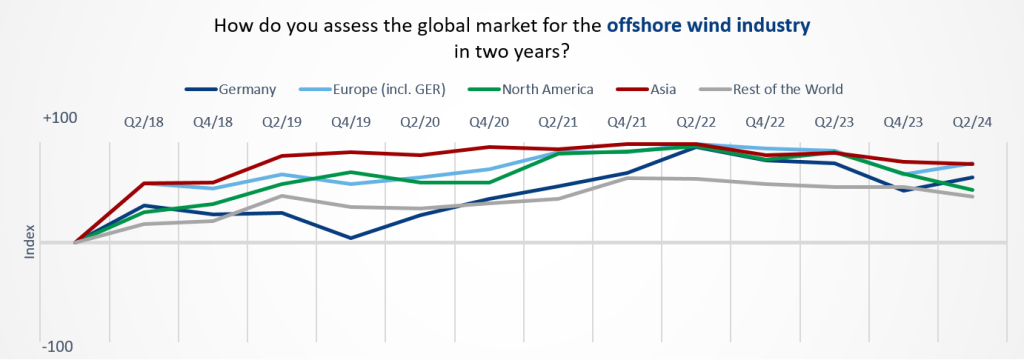
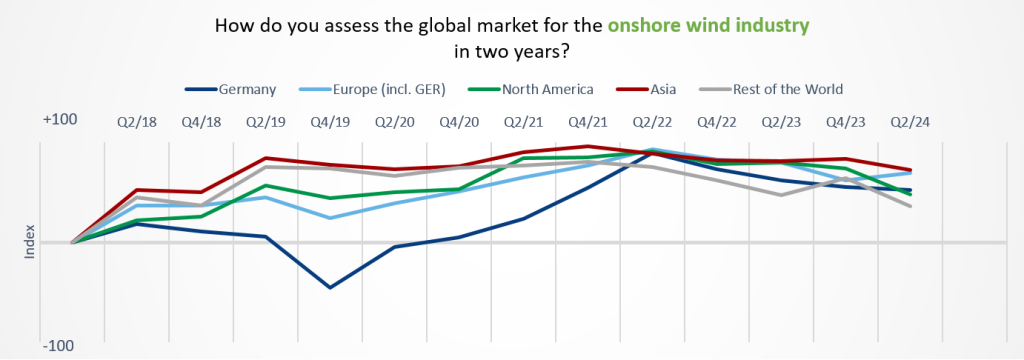
Compared to the previous six-moth period, the business environment for wind energy receives largely positive marks in this survey, with only Asia being seen in a less favourable light and Europe now pulling even. North America and the rest of the world have dropped below the assessment levels in Europe, the latter seeing a slight upturn of late, similar to those in Germany.
Offshore turbine sizes expected to grow; onshore retrograding
Following a surprising drop in the previous survey (probably prompted by the contemplated “moratorium ”), the average rated output per newly-installed offshore turbine expected by the year 2030 has increased significantly, from 18 to 19 MW. Several prototypes rated at around 22 MW were introduced at the end of 2023, putting pressure on the market. This is reflected in the current survey: 20 % of respondents anticipate output ratings between 22 and 25 MW.
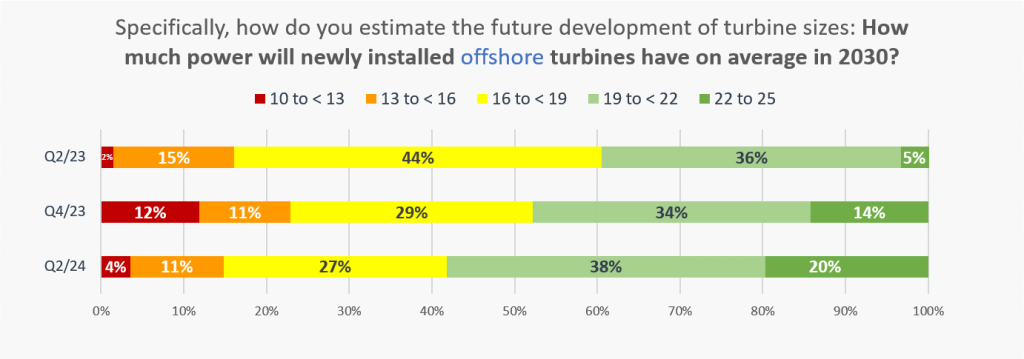
Compared to the previous edition of the WEtix, respondents now expect slighly lower output ratings for new onshore turbines installed by 2030, putting the mark at roughly 8.3 MW.
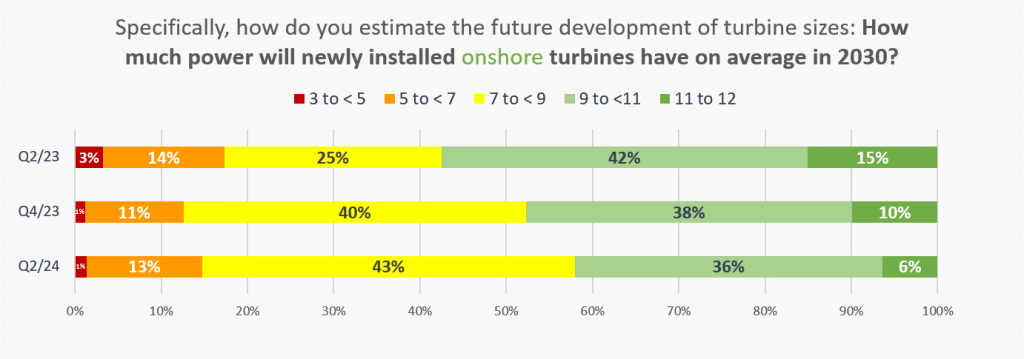
Permitting bureaucracy and slow grid expansion the biggest hurdles for development
While respondents agree that regulatory matters, permitting procedures and slow grid expansion are major obstacles for further development of both onshore and offshore wind power, misgivings are much more pronounced in the onshore segment. Quite a different picture is drawn in terms of CAPEX: Nearly every second respondent believes this to be a major hurdle for offshore wind. Similarly, technology challenges are seen as playing a much more prominent role in the offshore segment. Notably, the perception of hurdles in the offshore realm is generally less pronounced than onshore; for example, ratings for permitting issues are some 20 % lower than onshore.
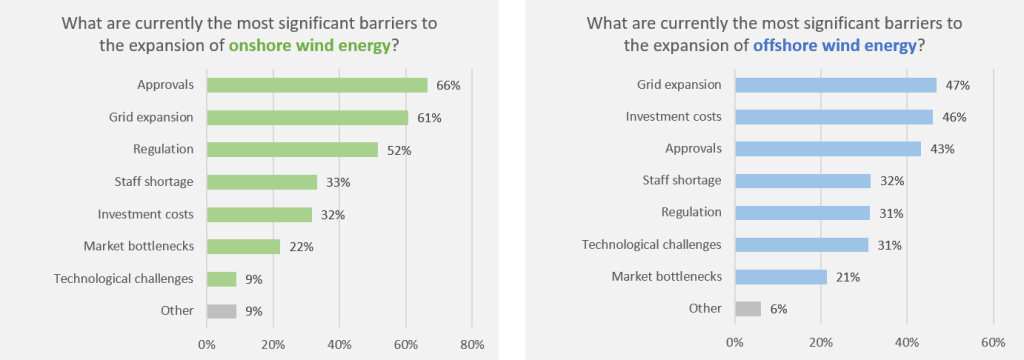
These are some of the summary results of the new WindEnergy trend:index (WEtix) which has been compiled at six-month intervals since 2018. The WindEnergy trend:index is published jointly by WindEnergy Hamburg, the global onshore and offshore wind energy event, and wind:research, a leading market research institute for wind energy. More than 800 respondents took part in the current survey between mid-March and mid-May 2024, sharing their assessments of developments in the global onshore and offshore wind industry. All in all, more than 12,000 online questionnaires have been completed by experts from the wind energy industry since 2018. The WEtix index covers all onshore and offshore regions globally. The following market regions were defined: Germany, Europe (including Germany), North America, Asia, and Rest of World (RoW).
About WindEnergy Hamburg
Every two years one of the most fascinating industries meets for the leading global networking event for wind energy: At WindEnergy Hamburg, which takes place right in the heart of the vibrant northern German port city, around 1,500 companies from 40 countries present their innovations and solutions in ten exhibition halls to up to 40,000 visitors from 100 different nations. Covering 75,000 m² across the exhibition campus, equipment manufacturers and suppliers representing all stages of the onshore and offshore wind energy value chain provide a comprehensive overview of the market. The trade fair is accompanied by conference sessions where top-ranking experts address the industry’s current key topics. The WindEnergy Hamburg team develop this programme jointly with their partners, including the Global Wind Energy Council (GWEC), the European organisation WindEurope, the national industry associations VDMA and BWE, leading industry media, and companies from the wind energy sector. From 24 until 27 September 2024, all conference sessions will take place free of charge on five open stages located inside the exhibition halls.
About wind:research:
The market research institute wind:research prepares market studies and analyses as well as expert reports, through to M&A services for the wind energy sector, delivering detailed insights for strategy development to energy utilities, project developers, operators, component and turbine manufacturers as well as municipal, state and federal governments. In addition, it publishes weekly clippings on a wide range of topics such as hydrogen. For further information go to: www.windresearch.de
About WEtix:
The WindEnergy trend:index, a mood barometer for the wind industry, is jointly compiled by WindEnergy Hamburg, the world’s leading expo for onshore and offshore wind energy, and wind:research, the leading wind energy market research institute. The survey focuses on examining the potential of wind energy, covering both the onshore and offshore segments.
About the survey:


























